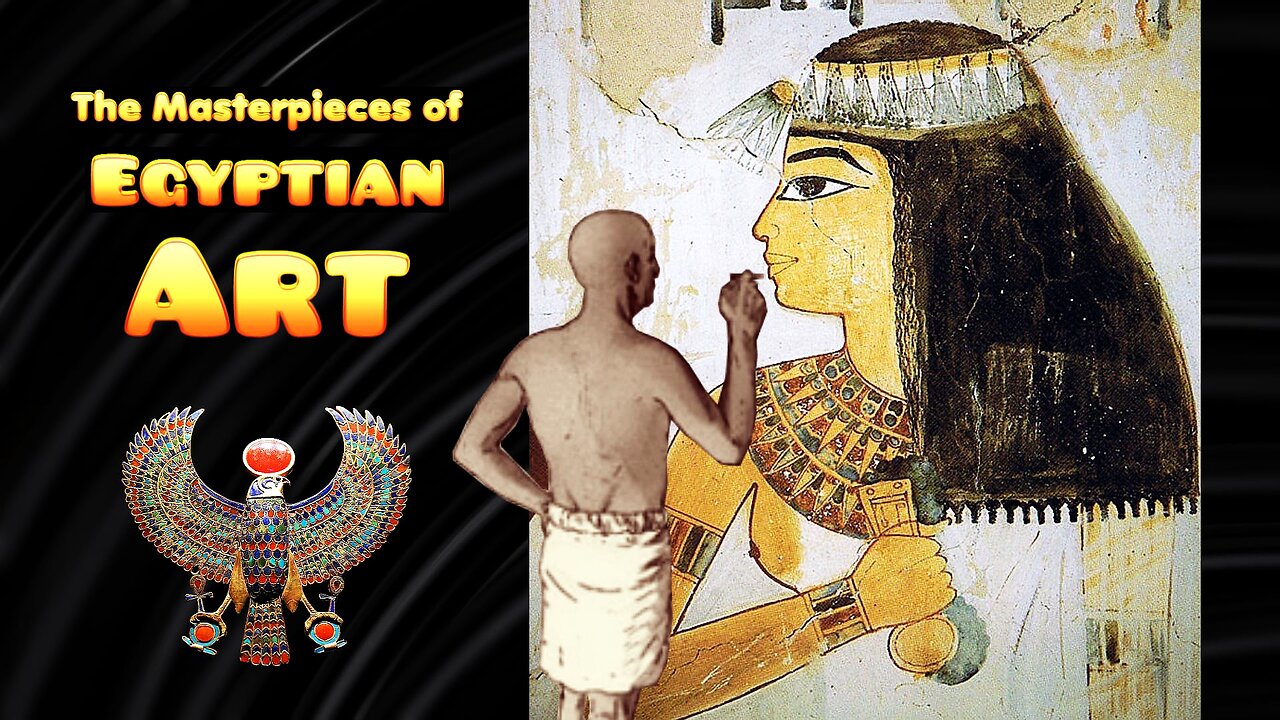Premium Only Content

Masterpieces of Ancient Egyptian Art - Great Painters and Sculptors
Ancient Egyptian art is renowned for its distinctive style, symbolism, and longevity. Here are some key features and aspects of Egyptian art:
- Symbolism and Representation:
Egyptian art was highly symbolic and often depicted gods, pharaohs, and important events. It aimed to convey eternal truths rather than realistic portrayal. representation.
- Hierarchical Scale:
Important figures, such as pharaohs or gods, were often depicted larger than others to denote their significance and power. This hierarchical scale was a common feature in Egyptian art.
- Material and Techniques:
Egyptians used various materials for their art, including stone, wood, metals, and pottery. They were skilled in carving reliefs and sculptures, as well as painting on walls, papyrus scrolls, and other surfaces. The use of vibrant colors, especially in wall paintings, was characteristic of Egyptian art.
- Subjects and Themes:
Egyptian art predominantly focused on religious and funerary themes. Scenes from daily life, such as farming, hunting, and domestic activities, were also common. Mythological narratives, particularly those involving the journey of the soul after death, were frequently depicted in tombs and temples.
- Funerary Art and Tombs:
Much of the surviving Egyptian art comes from tombs and burial sites. These artworks served both practical and religious purposes, providing provisions and protection for the deceased in the afterlife, as well as conveying religious beliefs about death and the afterlife.
- Tomb Paintings:
Wall paintings in tombs, such as those in the Valley of the Kings and the tombs of nobles, are famous for their elaborate scenes depicting the journey of the deceased through the afterlife, including encounters with gods, judgment scenes, and offerings to sustain the soul.
- Statuary:
Egyptian statues were often static and idealized representations of the subject, emphasizing permanence and divine attributes. The famous Great Sphinx and colossal statues of pharaohs, such as the statues of Ramses II at Abu Simbel, are prime examples of Egyptian statuary.
- Continuity and Tradition: Egyptian art maintained a remarkable continuity of style and themes over thousands of years, with changes occurring gradually and within a traditional framework. This stability was closely tied to the religious and cultural beliefs of ancient Egyptian society.
Overall, ancient Egyptian art is not only visually striking but also offers valuable insights into the religious beliefs, social structures, and cultural values of one of the world's oldest civilizations.
--
My channel "Atum" on YouTube
https://www.youtube.com/channel/UC4GrfTi1FYF87_wJnPxaSyA
My email
miladsidky1969@gmail.com
Donation via PayPal if you see my content worth watching
https://www.paypal.com/paypalme/miladsidkyatum
--
CREDITS
MUSIC
Desert Caravan - Aaron Kenny
Restless Natives - Doug Maxwell_Media Right Productions
Drums of the Deep by Kevin MacLeod is licensed under a Creative Commons Attribution 4.0 license. https://creativecommons.org/licenses/by/4.0/
Source: http://incompetech.com/music/royalty-free/index.html?isrc=USUAN1400021
Artist: http://incompetech.com/
--
Photos and vids
https://pixabay.com/photos/palette-paints-oil-painting-1482678/
https://pixabay.com/illustrations/wave-painting-drawing-artistic-81840/
https://pixabay.com/videos/black-abstract-background-lines-18327/
https://pixabay.com/illustrations/tree-pen-universe-write-stars-5831258/
--
Ancient Egyptian Artworks included:
Nebamun Hunting Fowl in the Marshes
https://commons.wikimedia.org/wiki/File:TombofNebamun-2.jpg
The beautiful Egyptian Woman
https://commons.wikimedia.org/wiki/File:Tomb_of_Nakht_(3).jpg
The Blind harper and the beautiful ladies
Musicians and dancing girls, and wine.
https://commons.wikimedia.org/wiki/File:Nebamun_tomb_fresco_dancers_and_musicians.png
Painting of Khai-Inherkha and wife enjoying music.
Female Dancers with castanets and musicians with tambourines
The three musicians
https://commons.wikimedia.org/wiki/File:Tomb_of_Nakht_-_three_musicians.png
An Egyptian Dancer painted on limestone ostracon from Deir el-Medina,
https://commons.wikimedia.org/wiki/File:Ostrakon_ballerina.jpg
https://creativecommons.org/licenses/by-sa/4.0
(Only background removed)
Statues of Rahotep and Nofret
Egyptian cat feeding and playing with her kittens
https://commons.wikimedia.org/wiki/File:Bronze_Saite_era_art_of_an_Egyptian_cat_in_the_Gulbenkian_Museum.jpg
https://creativecommons.org/licenses/by/2.0
(only unneeded background is removed)
Statue of King Pepi II and his mother
Isis nursing Horus
https://commons.wikimedia.org/wiki/File:Isis_nursing_Horus_MET_17.190.1641_right3_4.jpg
Tutankhamon Gold Mask
https://pixabay.com/photos/gold-mask-tutankhamun-munich-3847487/
Tutankhamun chair,
https://pixabay.com/photos/chair-golden-decorated-precious-484707/
Relief of Akhenaten and Nefertiti adoring the Aten
https://commons.wikimedia.org/wiki/File:La_salle_dAkhenaton_(1356-1340_av_J.C.)_(Mus%C3%A9e_du_Caire)_(2076972086).jpg
Egyptian Museum, Public domain, via Wikimedia Commons
Bust of Nefertiti
Syrian goddess Kadesh (the saint)
with Min, god of fertility, and Reshep, the warrior god.
https://commons.wikimedia.org/wiki/File:Stele_of_the_Syrian_goddess_Kadesh.JPG
Agricultural Scenes from the Tomb of Nakht
https://commons.wikimedia.org/wiki/File:Agricultural_Scenes,_Tomb_of_Nakht_MET_DT306954.jpg
Statuette of a woman preparing beer
Palette of Narmer
King Narmer strikes down the enemies of Egypt
https://commons.wikimedia.org/wiki/File:Narmer_palette_(obverse).jpg
Ramses II and his prisoners, the enemies of Egypt
https://commons.wikimedia.org/wiki/File:Ramses-ii-relief-from-memphis2.png
https://creativecommons.org/licenses/by-sa/4.0
(No changes are made)
Scene from the Egyptian Book of the Dead.
https://commons.wikimedia.org/wiki/File:Book_of_the_dead_egypt.jpg
Pectoral of Horus with sundisk
https://commons.wikimedia.org/wiki/File:Paris_-_Tout%C3%A2nkhamon,_le_Tr%C3%A9sor_du_Pharaon_-_Pendentif_au_faucon_portant_le_disque_solaire_-_001-gradient.jpg
--
TEXT: https://cooltext.com/Logo-Design-Outline
-
 6:46:07
6:46:07
Rance's Gaming Corner
16 hours agoTime for some RUMBLE FPS!! Get in here.. w/Fragniac
161K3 -
 1:30:48
1:30:48
Josh Pate's College Football Show
16 hours ago $10.57 earnedCFP Reaction Special | Early Quarterfinal Thoughts | Transfer Portal Intel | Fixing The Playoff
93.6K1 -
 23:55
23:55
CartierFamily
3 days agoElon & Vivek TRIGGER Congress as DOGE SHUTS DOWN Government
134K152 -
 5:43:44
5:43:44
Scammer Payback
2 days agoCalling Scammers Live
226K30 -
 18:38
18:38
VSiNLive
2 days agoProfessional Gambler Steve Fezzik LOVES this UNDERVALUED Point Spread!
162K20 -
 LIVE
LIVE
Right Side Broadcasting Network
10 days agoLIVE REPLAY: President Donald J. Trump Keynotes TPUSA’s AmFest 2024 Conference - 12/22/24
3,200 watching -
 4:31
4:31
CoachTY
1 day ago $28.83 earnedCOINBASE AND DESCI !!!!
197K13 -
 10:02
10:02
MichaelBisping
1 day agoBISPING: "Was FURY ROBBED?!" | Oleksandr Usyk vs Tyson Fury 2 INSTANT REACTION
118K16 -
 8:08
8:08
Guns & Gadgets 2nd Amendment News
2 days ago16 States Join Forces To Sue Firearm Manufacturers Out of Business - 1st Target = GLOCK
135K93 -
 10:17
10:17
Dermatologist Dr. Dustin Portela
2 days ago $19.84 earnedOlay Cleansing Melts: Dermatologist's Honest Review
169K19